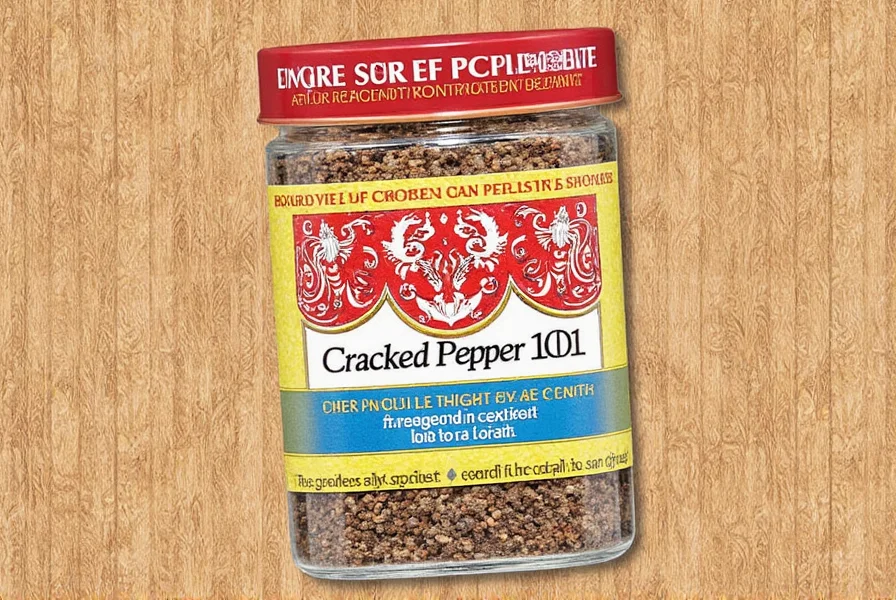Table of Contents
What Is Cracked Pepper?
Cracked pepper is a popular spice made by crushing whole black pepper berries (Piper nigrum) into small fragments. Unlike finely ground pepper, it maintains a coarse texture that releases flavor more gradually while providing visible specks and bursts of aroma in dishes. Originating from South India, black pepper has been used for over 4,000 years and remains one of the world's most widely consumed spices.

Cracked vs. Whole Pepper: What's the Difference?
| Feature | Whole Pepper | Cracked Pepper |
|---|---|---|
| Texture | Smooth, round, and intact | Coarse and uneven |
| Flavor Intensity | Milder and more subtle | Stronger and more aromatic |
| Usage | Used for infusing oils or soups | Added directly to dishes for immediate flavor |
While both come from the same plant, cracked pepper offers faster flavor release than whole peppercorns but slower than ground pepper. Its texture creates varied intensity in each bite, making it ideal for finishing dishes where visual appeal and layered flavor matter.
How to Use Cracked Pepper in Cooking
Cracked pepper's versatility makes it suitable for both everyday meals and gourmet dishes:
- Season meats: Sprinkle over grilled steak, chicken, or pork before cooking for enhanced depth.
- Enhance sauces: Add to tomato-based sauces, gravies, or marinades for complexity.
- Finish dishes: Use as a final touch on roasted vegetables, salads, or even popcorn.
- Infuse oils: Steep in olive oil for homemade flavored oils used in dressings or drizzling.
Unlike ground pepper, cracked pepper preserves volatile oils longer when stored properly, ensuring maximum freshness when used within 3-6 months.
Choosing Quality Cracked Pepper
Quality depends on three key factors:
- Origin: Regions like India, Vietnam, and Madagascar produce high-quality peppercorns with distinct flavor profiles.
- Freshness: Check packaging dates; fresh pepper has vibrant color and strong aroma. Avoid products stored near heat sources.
- Texture: Look for consistent fragment size without excessive fine particles. Coarse texture ensures better flavor release.
For maximum freshness, crack peppercorns yourself using a mortar and pestle just before use. Pre-cracked pepper is convenient but loses potency faster than whole peppercorns.
Frequently Asked Questions About Cracked Pepper
What exactly is cracked pepper?
Cracked pepper refers to black peppercorns broken into small fragments rather than ground into powder. This coarser texture releases flavor gradually, creating varied intensity in each bite compared to uniform ground pepper.
How is cracked pepper different from ground pepper?
Cracked pepper consists of larger fragments that provide a pronounced bite and slower flavor release, while ground pepper disperses evenly. The texture difference creates a more complex eating experience with bursts of flavor throughout the dish.
Can I make my own cracked pepper at home?
Yes. Place whole peppercorns in a mortar and use a pestle to crack them to your desired consistency, or crush them with the flat side of a chef's knife. For best results, crack immediately before use to preserve essential oils and aroma.
What dishes work best with cracked pepper?
Cracked pepper shines in dishes where visible specks and layered flavor matter: steak au poivre, roasted meats, grilled vegetables, creamy pasta, and salad dressings. Its texture enhances both visual appeal and flavor complexity.
How should I store cracked pepper to maintain freshness?
Store in an airtight container away from light, heat, and moisture. Unlike whole peppercorns (which last years), cracked pepper loses volatile oils within 3-6 months. Buy smaller quantities and avoid storing near stoves.
Is cracked pepper spicier than ground pepper?
No. Both forms contain the same capsaicin levels. However, cracked pepper's larger fragments create concentrated flavor pockets that may feel "hotter" in certain bites, while ground pepper distributes heat evenly. The difference is in delivery, not intensity.
Conclusion
Cracked pepper is more than a seasoning—it's a flavor enhancer that adds depth, aroma, and visual appeal to dishes. Understanding its unique texture, origin, and proper usage transforms everyday meals into culinary experiences. From ancient Indian roots to modern kitchens worldwide, this versatile spice continues to elevate cooking for both beginners and professionals.










 浙公网安备
33010002000092号
浙公网安备
33010002000092号 浙B2-20120091-4
浙B2-20120091-4